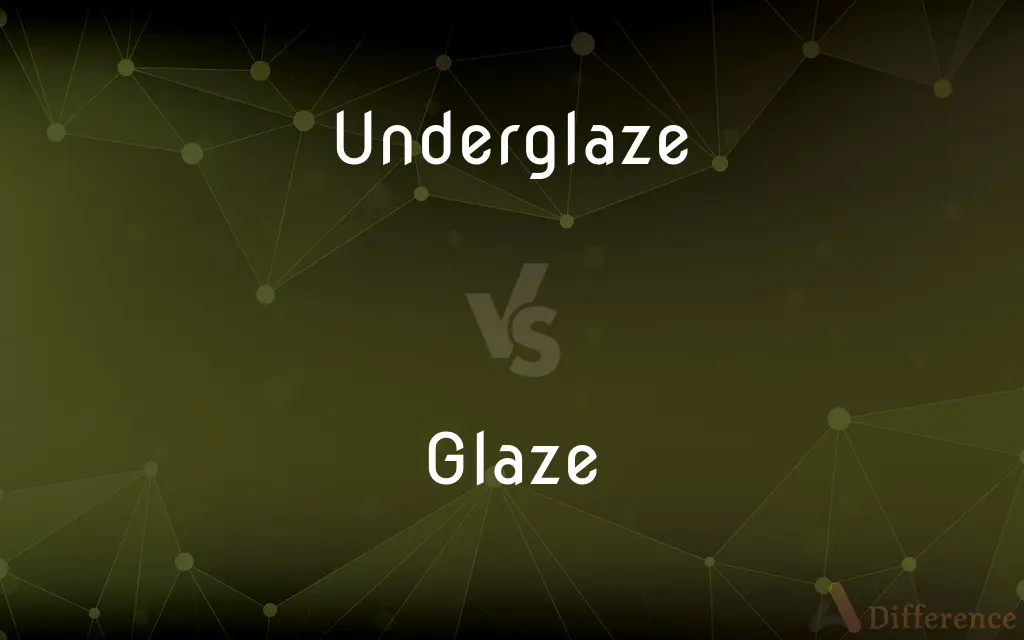Underglaze vs. Glaze — What's the Difference?
By Fiza Rafique & Maham Liaqat — Published on December 10, 2024
Underglaze is applied to pottery before it's glazed, allowing for intricate designs beneath the final shiny surface, whereas glaze is the final coating that vitrifies in the kiln, giving pottery its glossy finish.

Difference Between Underglaze and Glaze
Table of Contents
ADVERTISEMENT
Key Differences
Underglaze is a method of decoration where colors or designs are applied to pottery before it is glazed. This technique allows for detailed and intricate patterns to be embedded under the protective glaze layer, which adds depth and complexity to the final piece. On the other hand, glaze is a glass-like coating applied over the underglaze or directly on the bisque ware to seal the pottery, making it waterproof and giving it a glossy or matte finish after firing. The primary purpose of glaze is to enhance the durability and aesthetic appeal of ceramics.
While underglaze is typically made from a mixture of clay, pigment, and a liquid medium, allowing it to be absorbed into the porous surface of the bisque-fired pottery, glaze contains silica, which melts during the firing process to form a glassy surface. This difference in composition means that underglazes can be used to create designs that remain visible under the transparent or translucent final glaze, whereas glazes themselves contribute to the texture, color, and functionality of the ceramic piece.
Underglaze can be applied at various stages of the pottery making process, including on greenware (unfired clay) or bisqueware (once-fired clay), providing flexibility in the design process. In contrast, glaze is typically applied to bisqueware to ensure that the final surface is smooth and impermeable. This distinction highlights how each material is utilized at different stages for different purposes in the ceramic process.
Underglaze colors can change after the final glaze firing, depending on the chemistry of the underglaze and the glaze, as well as the firing temperature and atmosphere. This unpredictability can affect the final appearance of the design. Conversely, glazes are usually tested to produce consistent results under specific firing conditions, making them more predictable in terms of color and texture outcomes.
The choice between using underglaze, glaze, or both depends on the desired artistic effect and functional requirements of the pottery. Underglaze allows for detailed artwork beneath a protective layer, while glaze can add to the artwork’s durability and aesthetic with its finish. Each plays a crucial role in the creation of ceramic art, serving different purposes but often working together to achieve a piece's final look and functionality.
ADVERTISEMENT
Comparison Chart
Purpose
Primarily for decoration, applied before glazing
Seals and finishes pottery, applied after bisque firing
Composition
Mixture of clay, pigment, and liquid medium
Contains silica, forming a glassy surface when fired
Application Stage
Can be applied to greenware or bisqueware
Applied to bisqueware
Final Appearance
Can change color after firing
Generally provides consistent results
Functionality
Adds intricate designs under the final glaze layer
Enhances durability, waterproofness, and aesthetics
Compare with Definitions
Underglaze
Can be applied to both greenware and bisqueware.
The underglaze was painted on the greenware plate, preparing it for its first firing.
Glaze
Available in glossy, matte, and satin finishes.
He chose a matte glaze for a modern look on his ceramic dishware.
Underglaze
Allows designs to be sealed under the glaze.
After applying the underglaze, the bowl was glazed to preserve the intricate design.
Glaze
Seals the pottery, making it waterproof and durable.
The final glaze made the ceramic vase water-resistant and sturdy.
Underglaze
Color can change after final firing.
The red underglaze turned a deep burgundy after the piece was fired with a clear glaze.
Glaze
A glassy coating applied to pottery that vitrifies in the kiln.
The potter applied a clear glaze over the mug to give it a glossy finish.
Underglaze
A colored decoration applied to pottery before it is glazed.
The artist used underglaze to draw detailed patterns on the vase before firing it.
Glaze
Made from silica and other minerals.
The glaze recipe included silica, kaolin, and feldspar to achieve the desired texture.
Underglaze
Available in a wide range of colors for intricate designs.
She chose blue and green underglazes to create a sea-themed motif on the pottery.
Glaze
Generally provides consistent color and texture outcomes.
The blue glaze is known for its reliability, producing a rich hue every time.
Underglaze
Coloring or decoration applied to pottery before glazing.
Glaze
A thin smooth shiny coating.
Underglaze
A decorative slip applied to the surface of pottery before glazing.
Glaze
A thin glassy coating of ice.
Underglaze
To apply a decorative slip to the surface of pottery before glazing.
Glaze
A coating of colored, opaque, or transparent material applied to ceramics before firing.
Underglaze
Applied under the glaze, that is, before the glaze is put on; fitted to be so applied; - said of colors in porcelain painting.
Glaze
A transparent coating applied to the surface of a painting to modify the color tones.
Glaze
To incrust, cover, or overlay with a thin surface, consisting of, or resembling, glass; as, to glaze earthenware; hence, to render smooth, glasslike, or glossy; as, to glaze paper, gunpowder, and the like.
Sorrow's eye glazed with blinding tears.
Glaze
To apply thinly a transparent or semitransparent color to (another color), to modify the effect.
Glaze
Become glassy or take on a glass-like appearance;
Her eyes glaze over when she is bored
Glaze
Coat with something sweet, such as a hard sugar glaze
Common Curiosities
Can underglaze be applied on top of glaze?
No, underglaze is meant to be applied before glazing, as it needs to be sealed by the glaze.
Do underglazes always need to be covered with glaze?
While not always necessary, covering underglaze with glaze is recommended to make the piece waterproof and durable.
Can glaze be applied directly to greenware?
No, glaze is typically applied to bisqueware to ensure a smooth, impermeable surface.
What is the main difference between underglaze and glaze?
The main difference is their purpose: underglaze is for decoration beneath the glaze, while glaze provides a protective, decorative finish.
Can you mix underglaze colors?
Yes, underglaze colors can be mixed to create custom shades.
What is the role of silica in glazes?
Silica melts during firing to form the glassy surface that characterizes glazes.
Are underglazes and glazes interchangeable?
No, they serve different purposes in pottery making and are not interchangeable.
Can underglaze be used without glaze?
Yes, but the pottery will not be as durable or waterproof without a glaze layer.
Can you layer glaze over underglaze?
Yes, glaze is often applied over underglaze to seal the design and add a finish.
How does firing temperature affect underglaze and glaze?
Firing temperature can significantly affect the color and texture of both underglaze and glaze, with higher temperatures often leading to more vivid colors and stronger surfaces.
How do you test glaze color consistency?
Glaze color consistency can be tested by applying the glaze to test tiles and firing them under the same conditions as the final piece.
What happens if underglaze is applied too thickly?
If underglaze is applied too thickly, it can bubble or peel off during firing.
How do you choose between using underglaze or glaze?
The choice depends on the desired effect: underglaze for detailed designs under the finish, and glaze for the final surface texture and protection.
How do you fix a mistake made with underglaze?
Mistakes with underglaze can sometimes be sponged off before firing, depending on the stage of dryness.
Is it possible to refire a glazed piece?
Yes, a glazed piece can be refired, but the results can vary and may affect the glaze’s appearance.
Share Your Discovery

Previous Comparison
Definition vs. Declaration
Next Comparison
Hostname vs. Domain NameAuthor Spotlight
Written by
Fiza RafiqueFiza Rafique is a skilled content writer at AskDifference.com, where she meticulously refines and enhances written pieces. Drawing from her vast editorial expertise, Fiza ensures clarity, accuracy, and precision in every article. Passionate about language, she continually seeks to elevate the quality of content for readers worldwide.
Co-written by
Maham Liaqat













































